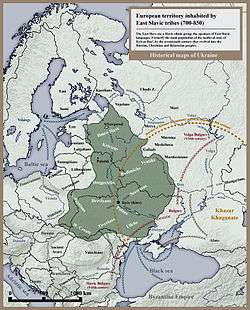Polans (eastern)

The Polans (Ukrainian: Поляни, Polyany), also Polianians, were an East Slavic tribe between the 6th and the 9th century, which inhabited both sides of the Dnieper river from Liubech to Rodnia and also down the lower streams of the rivers Ros', Sula, Stuhna, Teteriv, Irpin', Desna and Pripyat. In the Early Middle Ages there were two separate Slavic tribes bearing the name of Polans, the other being the western Polans (ancestors of the modern Poles), an unrelated West Slavic tribe.
The name derives from the Old East Slavic word поле, which means "field", because, according to Primary Chronicle they lived in the fields ("занеже в поле седяху").[1][2] In roughly 862 Polans were attached to ancient Rus'.
The land of the Polans was at the crossroads of territories, belonging to different Eastern Slavic tribes, such as Drevlyans, Radimichs, Drehovians and Severians and connected them all with water arteries. An important trade route called the Road from the Varangians to the Greeks passed through the land of the Polans and connected Northern Europe with the Black Sea and the Byzantine Empire. In the 9th and 10th centuries the Polans had well-developed arable land farming, cattle-breeding, hunting, fishing, wild-hive beekeeping and various handicrafts such as blacksmithing, casting, pottery, Goldsmithing, etc. Thousands of (pre-Polan) kurgans, found by archaeologists in the Polan region, indicate that that land had a relatively high population density. They lived in small families in semi dug-outs ("earth-houses") and wore homespun clothes and modest jewellery. Before converting to Christianity, the inhabitants used to burn their dead and erect kurgan-like embankments over them.
In the 860s, the Varangians (Vikings) arrived and organized a few successful military campaigns against the Byzantine Empire, who eventually defeated them and made peace with them, the Pechenegs and the Polochans.
The chronicles repeatedly note that socio-economic relations in the Polan communities were highly developed compared to the neighboring tribes. In the 880s, the land of the Polans was conquered by Oleg of Novgorod and the chronicles name the Polans among the founders of Kiev (see Kyi, Schek and Khoryv).[3]
According to chronicalized legends, the largest cities of the eastern Polans were Kiev, Pereyaslav, Rodnia, Vyshhorod, Belgorod (now Bilohorodka village at the Irpin river) and Kaniv. In the 10th century, the term "Polans" was virtually out of use and exchanged for "Rus", with eastern Polans as a tribe being last mentioned in a chronicle of 944.[4]
See also
References
- ↑ Primary Chronicle
- ↑ H. Łowmiański, Początki Polski, P. 2, Warszawa 1964, p. 66, 106.
- ↑ Г. Півторак, Українці: звідки ми і наша мова, Київ 1993, p. 77.
- ↑ П. П. Толочко, "Роль Киева в эпоху формирования Древнерусского государства," [In:] Становление раннефеодальных славянских государств, Киев, 1972, p. 129; Б. А. Рыбаков, Киевская Русь и русские княжества XII–XIII вв., Москва 1982, p. 98, 99; М. Ю. Брайчевский, Восточнославянские союзы племен в эпоху формирования древнерусского государства, [In:] Древнерусское государство и славяне, Минск 1983, p. 102-111.